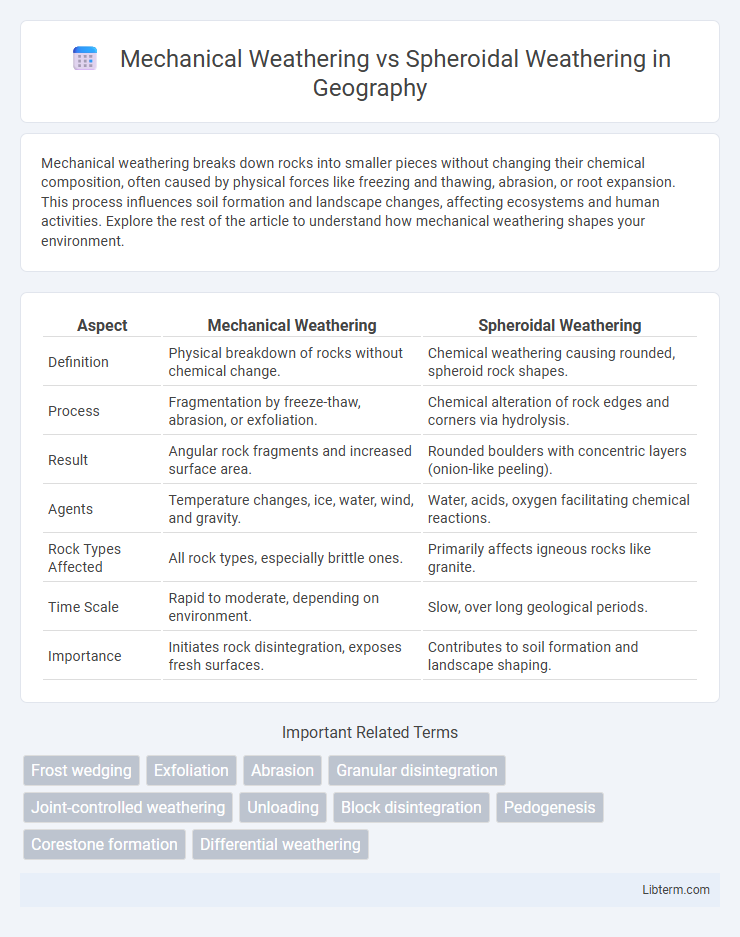Mechanical weathering breaks down rocks into smaller pieces without changing their chemical composition, often caused by physical forces like freezing and thawing, abrasion, or root expansion. This process influences soil formation and landscape changes, affecting ecosystems and human activities. Explore the rest of the article to understand how mechanical weathering shapes your environment.
Table of Comparison
| Aspect | Mechanical Weathering | Spheroidal Weathering |
|---|---|---|
| Definition | Physical breakdown of rocks without chemical change. | Chemical weathering causing rounded, spheroid rock shapes. |
| Process | Fragmentation by freeze-thaw, abrasion, or exfoliation. | Chemical alteration of rock edges and corners via hydrolysis. |
| Result | Angular rock fragments and increased surface area. | Rounded boulders with concentric layers (onion-like peeling). |
| Agents | Temperature changes, ice, water, wind, and gravity. | Water, acids, oxygen facilitating chemical reactions. |
| Rock Types Affected | All rock types, especially brittle ones. | Primarily affects igneous rocks like granite. |
| Time Scale | Rapid to moderate, depending on environment. | Slow, over long geological periods. |
| Importance | Initiates rock disintegration, exposes fresh surfaces. | Contributes to soil formation and landscape shaping. |
Introduction to Weathering Processes
Mechanical weathering breaks down rocks into smaller fragments through physical forces such as freeze-thaw cycles, abrasion, and pressure release, without altering the rock's chemical composition. Spheroidal weathering is a form of chemical weathering that results in the rounding of rock edges and corners due to the differential reaction between water and minerals, typically affecting jointed bedrock like granite. Both processes are fundamental in shaping landscapes by transforming bedrock into soil and sediment through distinct physical and chemical mechanisms.
Defining Mechanical Weathering
Mechanical weathering refers to the physical breakdown of rocks into smaller fragments without changing their chemical composition, primarily caused by processes like freeze-thaw cycles, abrasion, and thermal expansion. Spheroidal weathering is a specific form of chemical weathering that rounds off the edges of rock blocks through the decomposition of minerals, particularly along joints and fractures. Understanding mechanical weathering is crucial for studying how rocks disintegrate through natural physical forces before chemical alterations like spheroidal weathering occur.
What is Spheroidal Weathering?
Spheroidal weathering is a form of chemical weathering that causes rocks to break down into rounded shapes due to the progressive decomposition of minerals along fractures and edges. This process occurs when water penetrates rock joints, promoting the chemical alteration of minerals such as feldspar and mica, which weakens angular rock blocks and smooths them into spheroidal forms. Distinct from mechanical weathering, which physically breaks rocks without altering their chemical composition, spheroidal weathering primarily involves hydrolysis and oxidation reactions that modify the mineral structure within the rock.
Key Mechanisms of Mechanical Weathering
Mechanical weathering primarily involves physical processes such as freeze-thaw cycles, thermal expansion, and abrasion that break down rocks without changing their chemical composition. Freeze-thaw action causes water to infiltrate cracks, freeze, expand, and fracture the rock, while thermal expansion generates stress through temperature fluctuations. Abrasion occurs when particles collide and wear away rock surfaces, contributing to the disintegration of rock into smaller fragments.
Factors Influencing Spheroidal Weathering
Spheroidal weathering primarily occurs in coherent, jointed rock masses where water penetrates along fractures, facilitating chemical alteration of minerals within the rock. Factors influencing spheroidal weathering include rock composition, with feldspar-rich rocks like granite being more susceptible, and climate conditions, as warm, humid environments accelerate chemical reactions. The degree of jointing and permeability also significantly affect the extent of spheroidal weathering by allowing deeper water infiltration, promoting the rounded, exfoliated appearance characteristic of this weathering type.
Physical Changes: Mechanical vs. Spheroidal Weathering
Mechanical weathering involves the physical fragmentation of rocks into smaller pieces without altering their chemical composition, primarily caused by processes such as freeze-thaw cycles, abrasion, and thermal expansion. Spheroidal weathering, a subtype of chemical weathering with physical effects, results in the rounding of rock edges and corners due to differential weathering rates on jointed bedrock surfaces, often influenced by water penetration and mineral dissolution. The key distinction lies in mechanical weathering producing angular fragments, while spheroidal weathering creates smooth, rounded rock forms through combined physical and chemical processes.
Common Environments for Each Type
Mechanical weathering commonly occurs in environments with extreme temperature fluctuations, such as deserts and alpine regions, where freeze-thaw cycles cause rock fragmentation. Spheroidal weathering is typically found in humid, tropical, or subtropical climates with abundant moisture that promotes chemical alteration of rock edges, especially in jointed granitic terrains. Both processes shape landscapes, but their prevalence depends on climatic conditions and rock types.
Real-World Examples of Mechanical and Spheroidal Weathering
Mechanical weathering is exemplified by the freeze-thaw cycles observed in the Rocky Mountains, where water infiltrates cracks, freezes, expands, and fractures rock into smaller pieces. Spheroidal weathering occurs prominently in the granite landscapes of the Sierra Nevada, California, where chemical alteration rounds off blocky rock edges, producing smooth, concentric layers characteristic of spheroidal shapes. These distinct processes demonstrate how physical forces and chemical reactions shape geological formations in varied environments.
Implications for Landscape Evolution
Mechanical weathering breaks down rocks into smaller fragments without changing their chemical composition, accelerating surface erosion and contributing to jagged, angular landforms. Spheroidal weathering chemically alters rock edges, rounding them off and producing smooth, spherical boulders that influence soil development and slope stability. These contrasting processes shape landscapes by controlling rock disintegration rates, sediment distribution, and the formation of distinctive geomorphological features.
Summary: Mechanical vs. Spheroidal Weathering – Key Differences
Mechanical weathering breaks rocks into smaller fragments through physical forces such as freeze-thaw cycles, abrasion, and root expansion, without altering their chemical composition. Spheroidal weathering, a form of chemical weathering, involves the gradual rounding and peeling of rock layers due to water penetration and chemical reactions, primarily affecting jointed or fractured rocks. The key difference lies in mechanical weathering's physical fragmentation versus spheroidal weathering's chemical alteration that produces rounded rock shapes.
Mechanical Weathering Infographic

 libterm.com
libterm.com